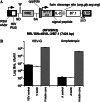An immune edited tumour versus a tumour edited immune system: Prospects for immune therapy of acute myeloid leukaemia
- PMID: 16450142
- PMCID: PMC11030980
- DOI: 10.1007/s00262-006-0129-7
An immune edited tumour versus a tumour edited immune system: Prospects for immune therapy of acute myeloid leukaemia
Abstract
Cell based therapies for acute myeloid leukaemia (AML) have made significant progress in the last decade benefiting the prognosis and survival of patients with this aggressive form of leukaemia. Due to advances in haematopoietic stem cell transplantation (HSCT) and particularly the advent of reduced intensity conditioning (RIC), the scope of transplantation has now extended to those patients previously ineligible due to age and health restrictions and has been associated with a decrease in transplant related mortality. The apparent graft versus leukaemia (GvL) effect observed following HSCT demonstrates the potential of the immune system to target and eradicate AML cells. Building on previously published pre-clinical studies by ourselves and others, we are now initiating a Phase I clinical study in which lentiviral vectors are used to genetically modify AML cells to express B7.1 (CD80) and IL-2. By combining allogeneic HSCT with immunisation, using the autologous AML cells expressing B7.1 and IL-2, we hope to stimulate immune eradication of residual AML cells in poor prognosis patients that have achieved donor chimerism. In this report we describe the background to cell therapy based approaches for AML, and discuss difficulties associated with the deployment of a chronically stimulated, hence exhausted/depleted immune system to eradicate tumour cells that have already escaped immune surveillance.
Figures


Similar articles
-
Lentiviral vectors for efficient delivery of CD80 and granulocyte-macrophage- colony-stimulating factor in human acute lymphoblastic leukemia and acute myeloid leukemia cells to induce antileukemic immune responses.Blood. 2000 Aug 15;96(4):1317-26. Blood. 2000. PMID: 10942373
-
Development of a whole cell vaccine for acute myeloid leukaemia.Cancer Immunol Immunother. 2006 Jan;55(1):68-75. doi: 10.1007/s00262-005-0674-5. Epub 2005 Oct 27. Cancer Immunol Immunother. 2006. PMID: 15891884 Free PMC article. Review.
-
Transduction of acute myeloid leukemia cells with third generation self-inactivating lentiviral vectors expressing CD80 and GM-CSF: effects on proliferation, differentiation, and stimulation of allogeneic and autologous anti-leukemia immune responses.Leukemia. 2002 Sep;16(9):1645-54. doi: 10.1038/sj.leu.2402582. Leukemia. 2002. PMID: 12200676
-
Immunological weapons against acute myeloid leukaemia.Immunology. 2002 Sep;107(1):20-7. doi: 10.1046/j.1365-2567.2002.01497.x. Immunology. 2002. PMID: 12225359 Free PMC article. Review.
-
Immunotherapy of myeloid leukaemia.Cancer Immunol Immunother. 2007 Jul;56(7):943-57. doi: 10.1007/s00262-006-0267-y. Epub 2006 Dec 20. Cancer Immunol Immunother. 2007. PMID: 17180671 Free PMC article. Review.
Cited by
-
Memory T cells need CD28 costimulation to remember.Semin Immunol. 2009 Apr;21(2):69-77. doi: 10.1016/j.smim.2009.02.005. Epub 2009 Mar 5. Semin Immunol. 2009. PMID: 19268606 Free PMC article. Review.
-
Analogue peptides for the immunotherapy of human acute myeloid leukemia.Cancer Immunol Immunother. 2015 Nov;64(11):1357-67. doi: 10.1007/s00262-015-1762-9. Epub 2015 Oct 5. Cancer Immunol Immunother. 2015. PMID: 26438084 Free PMC article. Review.
-
The complex role of B7 molecules in tumor immunology.Trends Mol Med. 2008 Dec;14(12):550-9. doi: 10.1016/j.molmed.2008.09.010. Epub 2008 Nov 3. Trends Mol Med. 2008. PMID: 18986838 Free PMC article. Review.
-
Targeting Toll-like receptor 7/8 enhances uptake of apoptotic leukemic cells by monocyte-derived dendritic cells but interferes with subsequent cytokine-induced maturation.Cancer Immunol Immunother. 2011 Jan;60(1):37-47. doi: 10.1007/s00262-010-0917-y. Epub 2010 Sep 22. Cancer Immunol Immunother. 2011. PMID: 20859626 Free PMC article.
-
Clinical evaluation of cellular immunotherapy in acute myeloid leukaemia.Cancer Immunol Immunother. 2011 Jun;60(6):757-69. doi: 10.1007/s00262-011-1022-6. Epub 2011 Apr 26. Cancer Immunol Immunother. 2011. PMID: 21519825 Free PMC article. Review.
References
-
- Schreiber RD. Cancer vaccines 2004 opening address: the molecular and cellular basis of cancer immunosurveillance and immunoediting. Cancer Immun. 2005;5(Suppl 1):1. - PubMed
Publication types
MeSH terms
LinkOut - more resources
Full Text Sources

